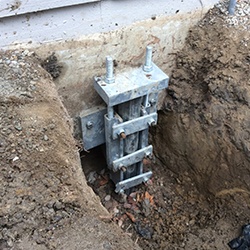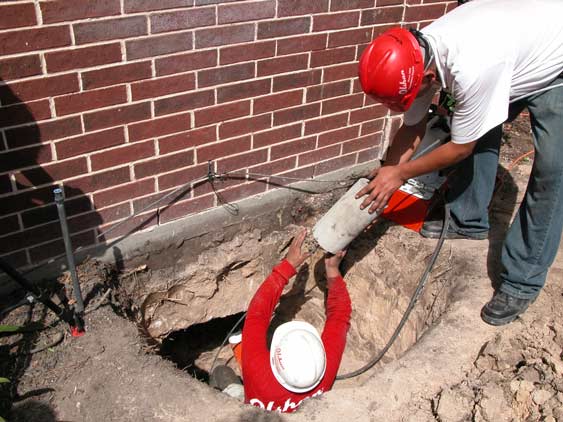Checking Out Different Approaches of Foundation Fixing for Various Soil Types
Structure repair work is a critical aspect of keeping structural stability, specifically when considering the varied challenges postured by various soil types. The intricacy of dirt behavior under differing problems demands a tailored strategy to repair, guaranteeing optimal remedies such as helical piers for unpredictable soils or chemical grouts for cohesive layers. The inquiry stays: exactly how do we establish the most reliable approach for each unique situation? Recognizing the interaction in between soil qualities and repair methods is critical, yet there is even more to uncover in the pursuit for sustainable remedies. What elements genuinely dictate the selection of technique?
Recognizing Soil Kinds
Dirt types play a crucial role in the security and long life of building foundations, making it vital for property owners and construction specialists to understand their features and actions. The interaction in between dirt and foundation can determine the structural honesty of a structure. There are a number of soil kinds, each with unique physical residential or commercial properties that impact how structures are created and kept.
Granular soils, such as sand and gravel, offer good drainage and are often taken into consideration stable. They have high load-bearing capabilities, which can sustain heavier structures. However, these soils can shift otherwise compacted properly, causing possible negotiation concerns. On the other hand, cohesive soils like silts and clays exhibit various behaviors. These dirts tend to retain moisture, and their load-bearing capacity can differ significantly with adjustments in wetness material.
Rocky dirts, recognized for their toughness and stability, offer superb support for structures yet might need specific devices for excavation. Alternatively, fertile dirts, which are a balanced mix of sand, clay, and silt, frequently supply desirable problems for structure assistance due to their modest water drainage residential or commercial properties.

Understanding these soil types is critical for choosing appropriate foundation repair service methods, ensuring the sturdiness and safety and security of frameworks in time.
Difficulties With Extensive Clay
Among the numerous soil kinds, large clay offers distinct obstacles for structure stability as a result of its tendency to undergo considerable volume changes with moisture variant. This kind of soil swells when damp and contracts when completely dry, which can apply significant stress on frameworks. These changes can lead to foundation cracking, heaving, and negotiation issues, positioning substantial risks to the architectural stability of structures.
The challenges with expansive clay are aggravated by its plasticity index, which gauges the dirt's capability to alter shape and volume. A high plasticity index suggests better capacity for movement, raising the possibility of damages to structures. This is specifically troublesome in areas experiencing extreme or regular weather changes, where cycles of damp and dry problems are usual.
Furthermore, the deepness of large clay layers can differ, complicating the evaluation and preparation of suitable foundation repair service approaches. The unpredictable nature of its activity necessitates specialized engineering options to alleviate threats. In addition, extensive clay can impact energy lines, sidewalks, and driveways, better complicating repair service initiatives. These complexities require an extensive geotechnical evaluation to make sure efficient foundation view website fixing techniques are implemented, emphasizing the relevance of addressing expansive clay obstacles with know-how and treatment.
Solutions for Sandy Soils
Sandy dirts, defined by their large bit dimension and low communication, present unique difficulties for foundation stability due to their tendency for moving and erosion. By anchoring the structure to much deeper, much more stable soil layers, these systems can provide the essential support to combat the moving nature of sandy soils.
One more recommended technique is the application of soil stabilization techniques. Chemical grouting, for example, entails injecting a maintaining agent into the soil, which improves cohesion and minimizes leaks in the structure. This process aids to solidify the sandy substratum, consequently minimizing the danger of disintegration and movement.
In addition, installing correct drainage systems is important in sandy soil conditions. Making sure appropriate water drainage can protect against water accumulation around the structure, which frequently worsens erosion and dirt displacement. Techniques such as French drains pipes or surface area grading can be used to guide water away from the building boundary.
Resolving Settling in Loamy Soils
Loamy soils, known for their balanced mix of sand, find out here now silt, and clay, provide a productive base for lots of frameworks but can often bring about structure settling as a result of their unique make-up. This well balanced structure supplies outstanding drainage and nutrient retention, making it suitable for farming and landscape design. However, this exact same quality can become problematic for structures, as shifts in wetness content can create the dirt to expand or agreement, causing resolving.
Accurate soil screening is vital to identify the details composition and dampness material of the loam. As soon as data is collected, implementing appropriate water drainage services is vital to preserve consistent wetness degrees, thus lowering the risk of soil contraction or development.

Ingenious Repair Work Techniques
In the world of structure fixing, innovative strategies are consistently being established to attend to the complex challenges posed by numerous soil conditions. As dirt types vary substantially in their structural buildings, traditional methods might not constantly are sufficient. The arrival of brand-new modern technologies in structure repair work gives a lot more tailored remedies, ensuring stability and durability.
One significant development is the use of helical piers, which are specifically efficient in unstable or extensive dirts (foundation repair okc ok). These piers are screwed into the ground till they get to a steady layer of dirt, providing strong assistance for the foundation over. This approach lessens disruption and is adaptable to different dirt kinds, making it a versatile solution
An additional cutting-edge strategy is the application of polyurethane foam injection. This technique entails injecting high-density polyurethane foam below the structure to load gaps and stabilize the structure. It is a less invasive alternative to standard foundation, using fast setup with marginal disruption to the surrounding area.
Furthermore, soil stabilization approaches, such as the usage of chemical cements, have gained traction. These compounds improve dirt toughness and decrease leaks in the structure, protecting against future moving. Collectively, these cutting-edge repair service strategies provide reliable solutions for the diverse challenges positioned by varying Continue soil conditions.
Conclusion

Foundation repair service is a crucial facet of preserving architectural honesty, especially when thinking about the diverse difficulties postured by different soil types (foundation repair Oklahoma). The intricacy of soil actions under differing problems necessitates a customized method to fix, guaranteeing ideal remedies such as helical piers for unsteady dirts or chemical cements for natural layers. By securing the foundation to much deeper, much more stable dirt layers, these systems can provide the necessary assistance to combat the shifting nature of sandy dirts
Structure fixing requires careful consideration of dirt types to make sure security and durability. Chemical grouts boost dirt strength and minimize leaks in the structure in cohesive soils.